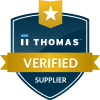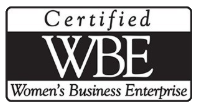MF Supply President, Robin Lieberman, selected to SBA Emerging Leaders class of 2015
NJ Based Supply Chain partner to Manufacturers one of 17 NJ businesses chosen for potential to achieve growth to the next level.
PRLog - April 23, 2015 - LODI, N.J.
Robin Lieberman, President of the NJ based Fastener and Electronic hardware supplier MF Supply, is one of 17 business leaders selected to the SBA Emerging Leaders Program
for the NJ class of 2015. The program had its kickoff meeting and first
class on April 14, 2015 at Rutgers Business School in Newark. The seven
month program runs through the end of October.
The SBA
Emerging Leaders Program is a federal training initiative that
specifically focuses on executives of businesses poised for growth.
Since its inception, the program has helped more than 2,000 small
business owners grow their businesses. Graduates of the program have
shown significant growth with over 1940 new full-time employees and over
$20 million in new financing. In addition, participants have secured
federal, state, local and tribal contracts cumulatively worth nearly
$300 million. The program's comprehensive curriculum provides the tools
to catapult companies to the next level and help them emerge as a force
in their community.
Ms.
Lieberman says, "I appreciate the opportunity to be included in this
very successful proven program. I'm excited to learn how to better
leverage MF Supply's assets, including our NJ Women Owned Business
Certification, to potentially secure government work. Moreover, one of
our main goals is the expansion of our products and services and the
growth of our client base. We're confident that the training, resources
and exposure we get from participation in the Emerging Leaders program
will lead to more manufacturers becoming aware of MF Supply and our
unique approach to supply chain operations."
With
New Jersey long known for a strong industrial base for aerospace,
shipbuilding, chemical manufacturing, agriculture, pharmaceuticals and
petro chemicals, this positions Lodi based MF Supply strategically to
continue serving this growing industrial market.
To learn more about MF Supply, call 973-777-5411.
________________________________________________________________________________________
Newsletter
Volume
11
October
30, 2014
What the heck are Set Screws?
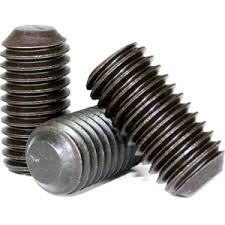
Set
Screws
We
begin the fourth quarter of 2014 with an introduction to the Set Screw. A Set
Screw is a headless screw (appropriate for our Halloween edition) fully
threaded from end to end.
Traditionally
classified within the Socket family of products, Set Screws are comprised of 3
main parts: the drive, the thread and the point.
They (generally) have a hexagonal drive on
one end, and a point on the other.
They
are often used in conjunction with a shaft collar, and like their functional
relatives, the Dowel Pin, Retaining Ring and Shoulder Screw, they are used as
part of an assembly (you should be getting used to reading about assemblies by
now :)).
Who
uses Set Screws?
Set
screws are used in many industrial and mechanical devices, particularly within
assemblies with rotating items such as pulleys or wheels where a component is
locked onto a shaft. Designed to fasten
one object inside another, set screws pass right through a threaded hole in the
outer object and are tightened against the inner object. Pretty cool, right?
The
set screw works by exerting compressional force through the tip to prevent the
relative movement between the two objects so each part can function as
intended. This is different than
traditional screws that hold objects together with threads. Who would have thunk that a headless screw
could have so much power!
What
options are available?
Like
most fastening products, the bevy of options is plentiful (and sometimes
exhausting if you ask me!). Once the
basics like the diameter, thread, length and material are determined, the main
decisions that need to be made are the drive and point style.
Drives
The
most common and readily available drive style is a hexagonal socket drive
(think allen wrench), however, set screws may also be available in slotted,
six-lobe (torx) and spline drives for certain sizes.
Points
This
is where it gets interesting. The point
of the set screw determines its function.
There are 7 (yes 7!) main points
that are available, and each serves a slightly different purpose.
1. Cup-the most common style, which is slightly
cupped to meet the surface of the inner object. Used for permanent or
semi-permanent installations, the Cup point provides a high level of security
and control. (Metric DIN 916)
2. Knurled Cup-a variation of the Cup point,
this style has knurls for a stronger grip.
3. Cone- a very sharp point wedges into the
inner object to hold it in place permanently. With the highest holding power of
all set screw styles, the Cone point is used for permanent settings. Note: Cone
point set screws may cause damage to the inner object which might not be
desirable in some applications. (DIN 914)
4. Flat-designed for flexibility when frequently
resetting or relocating objects on hard steel shafts where minimal damage to
shaft is necessary. Affordable and easy to install, Flat point set screws can
be moved without damaging the inner object. (DIN 913)
5. Oval-its point is the inverse of the cup
point. The small rounded contact surface
allows slight adjustments without loosening the screw, and causes minimal
surface damage to inner object. The
Oval point set screw is the most practical type for situations where the inner
and outer objects require regular adjustments.
6. Half-dog-sometimes offered as a full Dog
point, its protruding tip locks within a mating hole or slot in the shaft, for
permanent setting. Half dog/Dog points
are sometimes used instead of a dowel pin. (DIN 915)
7. Nylon tip - resembling a Half dog point, the
soft nylon tip is used to grip curved or textured surfaces.
Are
there other factors to consider?
From
what you've just read, it appears that the choices are abundant, yet, in
practice, many of the combinations that engineers are seeking are only
available as specials and have to be custom made. For example, if you are looking for a fine
thread cone point set screw in stainless steel, you may be told it has to be
custom made with a minimum run and a long lead time. Make sure to check with our sourcing experts
first before you change your requirements!
So,
you might be wondering how to get what you need and get it fast? In our experience, Set screws are most
commonly available in sizes 2-56 through 1" in imperial and M2-M24 in
metric diameters with a hex socket drive on one end and a cup point on the other.
The most common material is hardened alloy steel with a thermal black oxide
finish, as per ASME B18.3. Socket set
screws come standard with 3A thread fit and a Rockwell hardness of C45-53.
Commercial,
Mil-Spec or Brand name?
Finally,
Set Screws can also show up under their most popular domestic brand name
(Holo-krome) or their Mil-spec numbers, which are DFARS compliant with full
paperwork. AN565, NAS1081, MS18063, MS18064, MS18065, MS18066, MS18067,
MS18068, MS21342, MS51017, MS51021, MS51022, MS51023, MS51025, MS51026,
MS51029, MS51031, MS51033,MS51038, MS51040, MS51045, MS51047, MS51053, MS51476,
MS51477, MS51963, MS51964, MS51965, MS51966, MS51973,MS51974, MS51976, MS51977,
MS51981, MS51982.
Set
Screws Available at MF Supply:
Here
at MF Supply, we offer:
The
full range of commercial and mil-spec parts, including parts that are DFARS and
ROHS compliant.
Brand
names (Holo-krome) and generic equivalents.
Custom
made parts per print in non-standard and exotic materials and finishes.
Inch
and Metric sizes.
For
more detailed information on Set Screws, visit us at
http://www.mfsupply.com/category_s/1914.htm.
Newsletter
Volume 8
July
23, 2014
What the heck are Precision Shoulder
Screw
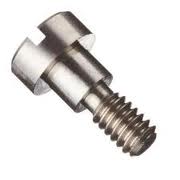
Precision Shoulder Screws
Here
we go again, with our "what the heck is that" series, where we
discuss some of the unique fasteners and electronic hardware that manufacturers
use in the design and assembly of their products. Today, we will introduce you
to the Shoulder Screw.
What is a Precision Shoulder Screw?
Shoulder
Screws, which are sometimes called Shoulder Bolts or Stripper Bolts, are
(generally) hex socket screws with an enlarged, unthreaded cylindrical shoulder
under the head. They are comprised of 3
main parts: the head, the shoulder and the thread. They come in two basic categories,
“Commercial” and “Precision”.
Commercial
Shoulder Screws
are made to inch standard ANSI ASME B18.8.2.
The size range for the shoulder diameter is from ¼ to 2”. The thread class is 3A and the tolerance on
the shoulder is +.005 / -.005.
Precision
Shoulder screws
are sometimes referred to as “tight tolerance” shoulder screws. They are not
governed by any official ANSI or ASME standard.
The size range for the shoulder diameter is from 3/32 to ½. The thread class is 2A and the tolerance on
the shoulder diameter varies from
+.000/-.001
to
-.0005 to -.0015 depending
upon the manufacturer. Now that’s
precise!
Who uses Shoulder Screws?
Just
as Dowel Pins and Retaining Rings are used to locate or hold parts together
within a precision assembly or a fixture, so are Precision Shoulder Screws.
Yet
shoulder screws are more versatile.
When
installed, the unthreaded shoulder acts as a shaft for rotating items such as
bearings and bushings, precision spacing, machinery support, and motion
guiding.
Precision Shoulder screws
exacting tolerances make them ideal for use with other precision components.
They
are broadly used across various applications in many industries, including:
aerospace, electrical motors, hydraulic equipment, instrumentation, tooling and
fixtures, machinery, military and many more.
What do I need to consider when
selecting Shoulder Screws?
Although
Shoulder Screws are offered in a multitude of materials and styles, when it
comes to the main commercial and precision offerings, there are a few main
issues to consider.
Which
Drive and Head Style?
Precision
shoulder screws are readily available in hex socket and slotted drives. Philips drives are available in certain
sizes. Torx and Star are available for
special order. Typical head styles are a
modified fillister with a flat top where the head diameter is about twice the
head height. Low head fillisters are
available in certain sizes
Which
material do I need?
Precision
shoulder bolts are readily available in Type 18-8/303 Stainless Steel and 416
Stainless Steel. 316 Stainless Steel,
Alloy and other exotic materials are available for special order.
Are
there other factors to consider?
When
ordering Precision Shoulder screws, specify the Shoulder Diameter, Shoulder
length, thread size, material and drive type. For example, an example of a
typical Precision Shoulder screw is a ¼ shoulder x ½ long x 10-32 thread in
SS18-8 with a hex-socket drive. Non-locking
is the most popular style, but locking may also be available.
Precision
Shoulder Bolts
often show up under their
brand name.
Some of the most popular
brands include: BERG, Concord, Globe, PIC, Lyn-tron and RAF. A comprehensive
selection of Shoulder Screws is also offered by McMaster-Carr (tight tolerance
series), MSC and Grainger.
Finally, Precision Shoulder Screws can also show up
under their Mil-spec numbers, which include MS51575 & MS51576 and are DFARS
compliant with full paperwork.
Precision Shoulder Screws at MF Supply
We
offer:
- The
full range of commercial and mil-spec parts, including parts that are DFARS and
ROHS compliant.
- Brand
names and generic equivalents.
- Custom
made parts per print in non-standard and exotic materials and finishes.
- Inch
and Metric sizes.
For
more detailed information on Precision Shoulder Screws, visit us at
http://www.mfsupply.com/SearchResults.asp?Cat=1922
_______________________________________________
Newsletter
Volume 7
June 19,
2014
What the heck are Dowel Pins?

Dowel Pins
Dowel Pins
Welcome back
to our "what the heck is that" series, where we discuss some of the
unique fasteners and electronic hardware that manufacturers use in the design
and assembly of their products. Today, we will introduce you to the Dowel Pin.
What is a Dowel Pin?
If you have
ever shopped at Ikea or assembled furniture on your own, then you are familiar
with the peg shaped non-threaded wooden pins that are used to join parts
together, aka as a Dowel Pin.
For the
purposes of manufacturing, Dowel Pins are solid, headless cylindrical shaped
straight metal pins with a centerless ground finish. Typically hardened and
manufactured to precise fractional diameters and lengths, Dowel Pins come in a
variety of sizes, styles, designs and materials that cause confusion among
buyers, engineers and end-users alike! Today, we will try simplify this
confusing category of fasteners.
Who uses Dowel Pins?
Dowel Pins
are used as a hinge, shaft or pivot to locate or hold parts together within a
precision assembly or a fixture.
They are
broadly used across various applications in many industries, including:
aerospace, electrical motors, hydraulic equipment, instrumentation, tooling and
fixtures, machinery, military and many more.
Dowel Pins
are popular within assemblies since they can withstand frequent insertion and
removal without distortion. And
production favors pins since they require no extra fastening hardware for
insertion, no secondary operations and no mating parts. All this adds up to speedier production,
which makes everyone in the food chain happy!
What do I need to consider when selecting
Dowel Pins?
Although
Dowel Pins are offered in a multitude of materials and styles, when it comes to
the main commercial and Mil-spec offerings, there are a few main issues to
consider.
Standard, Oversized or Undersized?
Standard
series Dowel Pins are used for initial applications. They have a basic diameter 0.0002 inch over
the nominal diameter. For example, a ¼ standard dowel will have a diameter
between .2501-.2503.
Oversized
series Dowel Pins are usually used to fit into worn holes and are generally
used in the aftermarket for repairs.
They have a basic diameter 0.001 inch over the nominal diameter. For
example, a ¼ oversized dowel will have a diameter between .2509-.2511.
Undersized
series Dowel Pins are used for inconsistent holes. They have a basic diameter -0.0002 inch under
the nominal diameter. For example, a ¼
undersized dowel will have a diameter between .2500-.2498. The Mil-P-21143/2-
falls into the undersized category.
Chamfer or radius on the end?
In general,
commercial pins are made to inch standard ANSI ASME B18.8.2. Standard alloy pins will have a radius on one
end and a chamfer on the other end.
However, stainless steel Dowel Pins are often manufactured with a
chamfer on both ends.
Commercial or Military?
If you or
your customer needs domestically made, DFARs pins to the most exacting
standards, then military may be the right pin for you!
Alloy or stainless? And which stainless for
that matter?
Alloy Steel
is the strongest pin available and is hardened. It can be finished with Black
Oxide to provide greater rust resistance than plain alloy.
Type 416
Stainless steel is the strongest standard stainless steel offering, and is the
material used for MS16555 and MS16556 series.
Magnetic.
Type
18-8/303 Stainless Steel is the most commonly available stainless offered and
is the standard material offered for Mil-P- 21143 series.
Type 316
Stainless Steel is the most corrosion resistant stainless available and does
not correlate to a Mil-spec part.
Are there other factors to consider?
Dowel Pins
often show up under their Mil-spec numbers, which can be crossed to commercial
equivalents. Some common Mil-spec series for Dowel Pins include Mil-P-21143
(303 Stainless), MS16555 (standard series offered in both alloy and 416
Stainless Steel) and MS16556 (oversized series offered in both alloy and 416
stainless steel).
If you are
not ordering by an MS or NAS Mil-Spec part number, then inch Dowel Pins conform
to ANSI/ASME B18.8.2. For commercial
pins, be mindful to specify the material and size tolerance that you need.
Unless noted, Dowel Pins are precision ground, hardened and heat treated to
meet the proper Rockwell hardness.
And
remember, no hammers! When installing Dowel Pins, never drive the pin into the
hole with force, always press it in for best results.
Dowel Pins at MF Supply
We
offer:
The full
range of commercial and mil-spec parts, including parts that are DFARS and ROHS
compliant.
Brand names
and generic equivalents.
Custom made
parts per print in non-standard and exotic materials and finishes.
Inch and
Metric sizes including DIN 7, DIN 6325, and ISO 2338 and 8734
For more
detailed information on Dowel Pins, visit us at
http://www.mfsupply.com/dowel_pins_s/1925.htm
_______________________________________________
Newsletter
Volume 6
May 13, 2014
What the Heck are Retaining Rings?
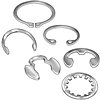
Welcome back to our "what the heck is that"
series, where we discuss some of the unique fasteners and electronic hardware
that manufacturers use in the design and assembly of their products. Today, we
will introduce you to the Retaining Ring.
What is a Retaining Ring?
Retaining Rings are yet another way to position, locate and
retain parts within an assembly. Shaped like an open ring and made of metal,
Retaining Rings can be coiled from wire, stamped or laser cut. They come in a
variety of styles and materials, each solving a unique fastening problem.
Generally, Retaining Rings work together with a bore or a
shaft by snapping into a groove or being pushed into place to create a high
strength shoulder to retain parts.
AKA - Also known as.....
The Retaining Ring is a funny little guy and answers to a
bunch of different names - some of Retaining Ring's favorite aliases are: snap
rings, wire rings, circlips, retainer clips, spiral rings, wire clips, c-rings,
grip rings, klip rings and push-on rings.
Who uses Retaining Rings?
Any application with a bore/housing or shaft that requires a
shoulder to keep parts in place within an assembly is a candidate for using
Retaining Rings.
Retaining Rings are broadly used across various applications
in many industries, including: aerospace, drive shafts, electrical motors,
hydraulic equipment, instrumentation, lighting assemblies, machinery, nuclear
equipment and many more. Retaining Rings are very common in the automotive
industry.
Why use a Retaining Ring vs. a screw or a bolt?
When a shaft or bore design that includes assembled
components needs a shoulder, it can be costly to machine the shoulder, mate
threaded components and fasteners together and drill and coordinate threaded
holes and access holes to fasten the assembly. Retaining Rings can serve as a
cost effective and time saving alternative.
In addition to cost, Retaining Rings offer 2 special
benefits a) they can be more resilient than screw assemblies in high vibration
environments, b) they are made from less material, hence they are cleaner and
gentler on the environment (aka Green!).
Check out this video:
http://machinedesign.com/manufacturing-equipment/r...
Are there other factors to consider?
As discussed, Retaining Rings are often referred to by their
brand names, which can often be substituted by generic equivalents. Popular
brands include: Anderton, Rotor Clip, S&M and Waldes/Truarc. We can supply
the brand name or generic alternatives. Note: Currently, Rotor Clip
(Waldes/Truarc) and S&M are the only full-line USA manufacturers.
Retaining Rings often show up under their Mil-spec numbers,
which can be crossed to commercial equivalents. Some common Mil-spec series for
Retaining Rings include: MS16624, MS16625, MS16626, MS16627, MS16628, MS16629,
MS16630, MS16631, MS16632, MS16633, MS3215, MS3217 and MS90707.
Sizes available vary based on the style. The general range
is from 1/16 to 10". Metric sizes are also available.
Retaining Rings at MF Supply
We offer:
The full range of commercial and mil-spec parts, including
parts that are DFARS and ROHS compliant.
Brand names and generic equivalents.
Custom made parts per print.
For more detailed information on Retaining Rings, visit us
at
http://www.mfsupply.com/SearchResults.asp?Cat=182...
And if you don't see it listed, as always, ask us. Finding
the right screw for you is our tag line after all!
________________________________________________
Newsletter
Volume 5
April 17, 2013
What the heck is a Keensert® Key-locking insert?
.jpg)
Key-locking insert
We close out the first quarter of 2013 by introducing you to
the Keensert Key-locking insert. Like its relative, the Helical wire insert,
(see January 2013), the Key-locking insert was originally designed to repair
parts with damaged threads.
What is a Keensert Key-locking insert?
The Key-locking threaded insert is a solid bushing style
insert that is threaded on both the inside and the outside, and has wedges or
“keys” attached to the top of the insert. Keensert® is the registered trademark
for one of the most popular brand names for this part and is used commonly to
describe this insert.
Who uses Key-locking inserts?
Generally, Key-locking inserts are used to distribute loads
and strengthen or repair threads against failures due to stripping, seizing or
corrosion. Key-locking inserts are commonly used in high torque and high
temperature situations, and in applications where fasteners may be repeatedly
removed and reassembled.
Typical applications are transmission housings, electronic
equipment and suspension units. Key-locking inserts are common in the aerospace
industry.
Why use a Key-locking insert vs. a Helical wire insert?
There are three main differences between Key-locking inserts
and Helical Wire Inserts: Key-locking inserts are stronger than helical wire
inserts, they are easier to install than helicals, and they are more expensive!
In heavy wear, high vibration and high heat situations where
saving space is not a concern and hole depth is limited, Key-locking inserts
are the best bet. Their “keys”, which are driven down into the tapped threads,
provide a mechanical lock against rotation, especially when the mating stud or
bolt will be removed frequently.
When reducing costs and minimizing space are priorities,
helical wire inserts are the way to go.
They are particularly useful for creating permanent strong
threads in softer materials such as aluminum, titanium and magnesium alloys,
and are best suited to lower heat and lower torque environments.
What styles are available?
Key-locking inserts come in four main styles: Miniature,
Thin Wall, Heavy Duty Wall (general purpose) and Extra Heavy Duty. Inserts can
be locking or non-locking.
Miniature Key-locking inserts are used in electronic and
aerospace applications where size and strength are critical. These inserts may
be installed in sheet material as thin as 1/16″.
Thinwall inserts have smaller external threads than standard
heavy-duty inserts and are ideal for tight spaces where less pull-out strength
is acceptable.
General-purpose Heavy Duty inserts have a thick, heavy-duty
thread wall, suitable for most applications.
Extra-Heavy Duty inserts are used in oversized and overly
worn holes.
Installation is 5 easy steps!
1) Drill with a standard tap drill and countersink with a
standard 82° – 100° countersink (90° for Miniature Inserts). Note: Drill is
oversize see charts for proper dimensions.
2) Tap new threads with a standard tap.
3) Screw in the insert until it is .010-.030 (.005-.015 for
Miniature Inserts) below the surface. Keys locate the proper depth.
4) Drive keys down with several hammer taps on the proper
installation tool.
5) You are done!
Considerations for selecting and using Key-locking inserts.
Inserts often show up under their Mil-spec numbers, which
can be crossed to commercial equivalents. Some common Mil-spec series for
Key-locking inserts include: MS5180, MS51831, MS51832, NAS1394, NAS1395,
NA0146, NA0147, NA0148, NA0149, NA150, NA0151.
As discussed, Key-locking inserts are often referred to by
their brand names, which can often be substituted by generic equivalents.
Popular brands include: Alcoa, Fairchild, Keensert and Tridair.
Materials available include Carbon steel, Stainless Steel,
Alloy 4140 and A286.
Diameters available: American – #6 to 1 1/2 ” and Metric –
M4 to M24
Key-locking inserts at MF Supply
We offer:
The full range of commercial and mil-spec parts
Products kits including single and multiple sizes
We are authorized distributors for Chrislynn and E-Z Lok
For more detailed information on Key-locking insert, visit
us athttp://www.mfsupply.com/Keensert_Style_Inserts_s/1864.htm
And if you don’t see it listed, as always, ask us. Finding
the right screw for you is our tag line after all!
________________________________________________
Newsletter
Volume 4
February 27, 2013
What the heck are Standoffs and Spacers?
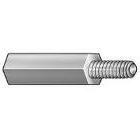
Male-Female Standoff
Welcome to our "what the heck is that" series,
where we discuss some of the unique fasteners and electronic hardware that
manufacturers use in the design and assembly of their products. Today, we will
introduce you to Standoffs and Spacers.
What are Standoffs and Spacers?
According to the dictionary, a Standoff is defined as
"a stalemate or a deadlock between two equally matched opponents." In
the fastener world, Standoffs have a different meaning. They are commonly used
to mechanically support and electrically connect and position components within
assemblies. Spacers are similar to Standoffs, however, Standoffs are threaded
on both ends, and spacers are unthreaded with an inside clearance hole.
Who uses Standoffs and Spacers?
In the world of electronic hardware and components,
Standoffs and Spacers are the standard for connecting and mounting circuit
boards, panels, doors and gears. Both are commonly used to properly position
parts within an assembly, to reduce component contact, to elevate stacked
sections, to ensure enough room for heat to dissipate and to separate or create
space between two objects.
What styles are available?
Standoffs and Spacers are available in a variety of styles
based on four main attributes: 1) shape 2) outer diameter of the body 3) body
length and 4) thread size or clearance hole. Standoffs have a fifth attribute,
thread type (we like to call it gender), as defined below.
Standoffs and Spacers can be hex, round or square shaped.
For standoffs, thread style comes three ways:
1) Female-female: can be fully threaded or partially
threaded on each end.
2) Male-female: have internal female threads on one end and
male threads on the other. Threads are generally the same size.
3) Male-male: have external threads on both ends which may
be of differing thread size.
Common materials include aluminum, brass, phenolic,
plastic/nylon, steel and stainless steel. Common platings include clear
anondized, nickel, gold iridite and zinc plated. There are over 20 common
platings available!
Some Standoffs are swaged, which means the parts have a
shank at one end used to rivet or swage it into the circuit board.
Lesson Learned, considerations when selecting and using
Standoffs and Spacers
Standoffs are sometimes referred to by their brand names,
which can often be substituted by generic equivalents. Popular brands include:
Amatom, Concord, Globe, H.H. Smith, Lyn-tron, Microplastics, Keystone, Pem,
RAF, Unicorp.
To measure a Standoff or Spacer, measure the outside
diameter of the body, the length of the body and the thread size. Determine if
the standoff is a female-female, male-female or male-male. Here is a hint: the
male part is externally threaded. A typical Standoff might measure as follows:
1/4 hex x 1/2 long x 8-32 thread male-female aluminum standoff. This exact
standoff is made and branded by at least 10 manufacturers.
Standoffs are sometimes called out by their body length and
thread dimensions. For example, an engineer might order a ½ x 8-32 standoff. It
is often assumed that the outside diameter is ¼ and the standoff is a
female-female configuration.
Phenolic standoffs and spacers are becoming less common.
Check with your engineering department to determine if nylon is an appropriate
substitute for phenolic. Nylon is less expensive and easier to come by.
Standoffs and Spacers sometimes show up under their Mil-spec
numbers, which can be crossed to commercial equivalents. Some common Mil-spec
series include NAS42, NAS43, NAS61, NAS1056, NAS1057, NAS1829, NAS1830, NAS1831
Jackscrews are a special type of male-female standoff that
can come with nuts and washers. Jackscrews are often used when the motherboard
is attached to the computer chassis.
Standoffs and Spacers at MF Supply
Here at MF Supply, we supply some of the most common and
unusual Standoffs and Spacers, including:
The full range of commercial and mil-spec parts
Specials sizes, materials and platings. Just try to stump
us!
We are authorized distributors for Amatom, Concord,
Lyn-tron, Microplastics and RAF and offer the full range of brand names and
equivalents.
For more detailed information, visit us at
http://www.mfsupply.com/SearchResults.asp?Cat=183...
And if you don't see it listed, as always, ask us. Finding
the right screw for you is our tag line after all!
________________________________________________
Newsletter
Volume 3
February 18, 2013
What the heck is a Wire Insert?

Wire Inserts
Welcome to our “what the heck is that” series, where we
discuss some of the unique fasteners and electronic hardware that manufacturers
use in the design and assembly of their products. Today, we will introduce you
to the Wire insert which was originally designed to repair parts with damaged
threads, but has evolved for use in a variety of applications that save time
and money and improve product reliability. Do we have your attention? Great,
then read on…
What is a Wire Insert?
Wire inserts are precision-formed continuous wire coils that
provide permanent, wear-resistant threads which exceed the strength of the
parent material. Often underestimated, the popular misconception is that Wire
inserts are intended solely for thread repair, when, in fact, they have other
significant uses discussed in the next section. Not to be confused with other
types of solid inserts or rivnuts, Wire inserts resemble springs and are
sometimes referred to as "helicals".
Who uses Wire Inserts?
Wire inserts are used for 3 main reasons: 1) to repair
damaged threads in parts that would otherwise have to be scrapped; 2) to
strengthen threads against failures due to stripping, seizing or corrosion; 3)
to convert threads between inch and metric sizes. We told you they were
versatile!
What styles are available?
Wire inserts come in 2 main styles: tang and tangless.
The original and widely used tang style has a prong at one
end to facilitate installation. The newer tangless style is becoming popular
since this style had no prongs to break off, retrieve, or lose and is easily
adjusted or removed after installation. Tangless inserts are commonly used in
electronic applications where loose tangs might cause damage.
Wire Inserts can be free-running or locking
Free running is the most common style used for thread
repair. The "free" diameter of the insert is larger than the
installed diameter and this configuration generates balanced pressure
distribution between the coils and threads.
Locking style inserts are recommended for applications that
require constant torque, or are subject to stress or vibration. The locking
style features a crimped turn that acts as a locking mechanism that grips the
bolt or screw to prevent loosening from vibration, eliminating the need for
lock wiring, lock-nuts, lockwashers, pellets/patches or other thread locking
devices.
A third commonly used insert that deserves an honorable
mention is a K-type Insert. Sometimes called by the brand Keensert, these
externally threaded solid style inserts can be used in almost any material:
aluminum, magnesium, cast iron, carbon steel, stainless steel and plastic.
K-type inserts have locking "keys" that provide a mechanical lock,
and are commonly used in heavy wear and high vibration situations.
5 Features & Benefits of Wire Inserts
1. Repair rather than scrap parts - Wire inserts remain the
most cost effective, efficient and fastest method to repair damaged threads.
2. Stronger Assemblies - The flexibility of the insert
provides a more balanced load distribution, practically eliminating thread
erosion and providing better stress allocation, even in low strength materials.
3. Wear and Corrosion Resistance - Thread life is increased
as thread friction is virtually eliminated, which becomes valuable in
applications requiring repeated assembly and disassembly. Surface coatings are
available for applications involving severe corrosive and extreme temperature
conditions.
4. Minimize space and weight - Lighter and less expensive
than other thread inserts, these wiry fellows can be incorporated into existing
designs, often allowing the use of thinner or lighter parent materials.
5. Convert threads from Metric/Inch - Rather than replace
all your hardware, taps and dies, you can use Wire inserts to convert threads
and use your existing hardware and tools.
Lesson Learned, considerations when selecting and using Wire
Inserts
Inserts are easy to install! You can use standard drill bits
and plug taps to drill and tap the hole.
For high volume installations, consider strip feed inserts
or use automatic or air-driven installation tools.
Inserts often show up under their Mil-spec numbers, which
can be crossed to commercial equivalents. Some common Mil-spec series include
MS122076 thru MS122275, NAS1130, MS124651 thru 124850, MS21208, MS21209,
MS122076, MS33537, MA3279, MA3329, NA0276.
Wire inserts are sometimes referred to by their brand names,
which can often be substituted by generic equivalents. Popular brands include:
Helicoil, Kato, Keensert and EZ Lok.
Materials available include 18-8 stainless steel, phosphor
bronze, X 750 Inconel, 316 Stainless steel and inserts may be lubricated or dry
filmed to offer easy threading and corrosion protection.
Wire Inserts Available at MF Supply
Here at MF Supply, we supply some of the most common and
unusual Wire inserts, including:
The full range of commercial and mil-spec parts
Products kits including single and multiple sizes
Specials including Giant metric, 8-pitch kits, left hand
kits and special lengths and diameters
We are authorized distributors for Chrislynn and E-Z Lok
For more detailed information on Wire inserts, visit us at
http://www.mfsupply.com/SearchResults.asp?Cat=182...
And if you don't see it listed, as always, ask us. Finding
the right screw for you is our tag line after all!
________________________________________________
Newsletter
Volume 2
August 22, 2012
What the heck is Mil-spec DFARS?

MS24693C
Welcome to the second edition of our “What the heck is that”
series, where we discuss some of the unique fasteners and electronic hardware
that manufacturers use in the design and assembly of their products. If you
sell to the military either directly or indirectly, then you are probably aware
of today’s topic: “DFARS” and “Mil-spec fasteners”.
What does Mil-spec mean anyway?
Before we get into the nitty gritty of DFARS, let’s discuss
what makes a “Mil-spec” fastener. Mil-spec is the informal name for the military
standard the U.S. Department of Defense uses in the production of military
equipment. For example, the MS24693C pictured above is a fastener produced
according to military standards.
Mil-spec fasteners look a lot like their civilian cousins,
but, these little guys are made to a specific standard that defines in detail,
the screw’s attributes, including: dimensions, tensile strength, hardness,
threads, drive type, material qualities and plating, just to name a few.
Mil-spec fasteners are even traceable by lot to designated manufacturers.
The government maintains a list of factories and suppliers
who are qualified to manufacture and distribute Mil-spec fasteners. These
suppliers have met all the government’s requirements and pass the highest
quality control standards. This designation is called Qualified Suppliers List
for Distributors [QSLD] and the Qualified Suppliers List for Manufacturer’s
[QSLM].
AKA - Also known as…..
Mil-spec fasteners are usually designated by an AN, MS, NAS
or NASM prefix followed by a part number. Each of these prefixes is an
abbreviation: NAS stands for National Aerospace Standard and MS stands for
Military Standard. An example of one of the most common and popular Mil-spec
machine screws is the MS24693C. Its commercial equivalent is a Phillips Flat
100 degree Machine Screw in 300 series stainless steel. Below, we’ll tell you
more about this popular fellow.
Who uses Mil-spec Fasteners?
Mil-spec fasteners are used by anyone manufacturing or
servicing military equipment. Often, the bill of materials calls for specific
Mil-spec grade fasteners in accordance with a part number, drawing or
procurement requirement. Some of the most common uses of Mil-spec fasteners
include aerospace and naval vessels.
Now, tell me about DFARS...
Almost a decade ago, the term “DFARS Compliant Material”
came to the forefront for companies supplying parts and services to the
government. The original Federal Acquisition Regulation (FAR) clause
252.225-7014 specified “A Preference for Domestic Specialty Metals.” What that
means in our world is that for fasteners to be DFARS compliant, the metal used
to fabricate them must be melted or manufactured in the United States or a
qualifying country.
Qualifying countries include: Australia, Austria, Belgium,
Canada, Czech Republic, Denmark, Egypt, Finland, France, Germany, Greece,
Israel, Italy, Luxembourg, Netherlands, Norway, Portugal, Spain, Sweden,
Switzerland, Turkey, United Kingdom of Great Britain and Northern Ireland.
Important Note: DFARS only pertains to fasteners made from
“specialty metals” including: stainless steel, high alloy steel like Grade-BD,
or Grade 5 Chromium steel with high chromium content.
To keep up to date with DFARs requirements, visit
www.acq.osd.mil/dpap/dars/dfarspgi/current/index.... section 252.225
An example of a DFARS Mil-Spec Screw please!
As we’ve learned, the MS24693C is actually Phillips Flat 100
degree Machine screws in 300 series stainless steel. The MS24693-C4 is a 4-40 x
3/8 Phillips Flat 100 Degree Machine Screw in 302 Stainless Steel, and it is
one of the most widely used sizes. Interestingly, the MS24693C superseded the
AN662C series, so you might come across the AN662C on an older print of bill of
materials. Keep in mind, with any design or manufacturing decision, the reason
for using a specific screw generally rests in the hands of engineering.
Features of the MS24693C
Strict military standards ensure performance and reliability
Made/melted in the USA or other DFARs-approved country
Materials and dimensions meet Federal standard FF-S-92
Inspected per Mil-I-45208
Full lot traceability, manufacturer’s certification and
chemical and physical certification
Available in diameters from #0 through 1/4 inch in coarse
and fine thread and various lengths
Lessons Learned: Considerations when purchasing MS24693C or
other Mil-spec DFARs fasteners
Always ask for “full certifications”. This includes part
name, part description, date of manufacture, lot number, chemical composition
of material, and treatment of material including plating or passivation.
At point of purchase,
make sure the screws are DFARS. If you do not specifically ask for
DFARS-compliant screws, you might receive screws that don’t meet the DFARS
requirements, in which case, they won’t meet military standards. We’ve learned
this the hard way so hopefully you don’t have to!
MS24693C and other Mil-spec DFARS Fasteners in Stock at MF
Supply
Here at MF Supply, we stock some of the most common Mil-spec
Fasteners, including the following: Machine Screws, Socket Screws, Hex Head Cap
screws, Nuts, Flat washers and Standoffs and Spacers.
Visit us at www.mfsupply.com/v/vspfiles/assets/images/MFSUPPL...
for our military linecard.
For more detailed information on Mil-spec Fasteners, visit
us at
www.mfsupply.com/SearchResults.asp?Cat=1823
And if you don’t see it listed, as always, ask us. Finding
the right screw for you is our tag line after all!
________________________________________________
Newsletter
Volume 1
May 17, 2012
What the heck is a Cage Nut?

A Cage Nut contains a free floating threaded square Nut
retained within a spring steel cage. The spring steel cage has two Mounting
legs or wings that, when pressed together, allow the nut to clip into the
square hole and lock the fastener in place within the rack hole.
Who uses Cage Nuts?
Cage Nuts are commonly used to mount lighting systems,
electrical equipment or instruments onto rail racks. The Cage Nut clips into
the rack's square mounting hole and usually positions the Nut toward the inside
of the rack. The Nut is typically loose or "floating" in the Cage to
allow for adjustments when installing the screw. This configuration allows
flexibility in mounting and assembling components.
AKA...Also Known As..
Cage Nut is a funny little guy and answers to a bunch of
different names - some of Cage Nut's favorite aliases are: Grip Nuts, Retainer
Nuts, Rack Nuts or Floating Nuts. Lots of monikers!
Advantages of Cage Nuts
Snap directly into square rack holes
Easily installed with no special tools or skills,
eliminating the need for special operations
The nut floats within the spring-steel cage which offsets
normal hole misalignment
Can be easily popped out and replaced
Ideal when removal or installation of rack components might
cause holes to strip
Combines flexibility of spring steel cage with the strength
of a threaded nut
Lessons Learned when selecting Cage Nuts
I always recommend purchasing the corresponding screw to go
with the Cage Nuts (i.e. buy the 3/8-16 Cage Nuts together with the 3/8-16
screws). This prevents you from selecting the wrong size Cage Nut. To be 100%
sure, you should do a quick test to make sure the screws and Cage Nuts fit
together before beginning the installation process.
When it comes to installation, Cage Nuts can be tough on
your fingers when trying to install or uninstall them with your bare hands.
Consider using a Cage Nut Tool.
Sizing is based on 3 components: the screw thread, panel
thickness and mounting hole. Double check your measurements before you make
your purchase.
Cage Nuts at MF Supply
Here at MF Supply, we stock some of the most common Cage Nut
sizes and styles, from 6-32 up to 1/2-13, in Stainless Steel and Steel Zinc.
For more detailed information on our Cage Nuts, visit us at
http://www.mfsupply.com/SearchResults.asp?Cat=185...



.jpg)





 Call Now!
Call Now! 
